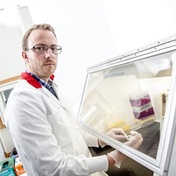Researchers have identified a genetic mutation common to roughly one-third of two devastating neurological disorders, amyotrophic lateral sclerosis (ALS) and frontotemporal dementia (FTD).
ALS, also known as Lou Gehrig's disease, destroys the motor neurons of the brain and the spinal cord, which are responsible for voluntary movement. ALS patients become progressively more paralysed, and often die within a few years of diagnosis.
FTD is a type of dementia that occurs when the frontal and temporal anterior lobes of the brain atrophy. People with FTD develop erratic behaviour, emotional problems, trouble communicating and difficulty with walking and other basic movements.
As with ALS, FTD is often fatal within a few years, according to the US National Institute of Neurological Disorders and Stroke (NINDS).
Now, an international team of researchers has found that about one-third of people who have familial ALS and FTD have a mutation on a specific gene, C9ORF72, that resides on chromosome 9.
Genetic cause of ALS
The finding has led researchers to suggest that rather than being two separate diseases, ALS and FTD should be thought of as one condition with symptoms that lie along a spectrum.
"When we look at the families in our study, many of the patients had ALS, many had FTD and the remaining had ALS and FTD," said senior study author Dr Bryan Traynor, chief of the Neuromuscular Diseases Research Group at the US National Institutes of Health. "Although clinically they have always been described as two separate diseases, they are overlapping. We now believe that ALS and FTD are actually different clinical manifestations of the same disease."
The hope, he added, is that a better understanding of the underlying genetic root cause of both diseases could lead to more effective treatments.
"It gives us a target. It's a shortcut," Traynor said. "We now have a map. Instead of having to figure out what's at the end of every street, we now know the routes to the city and we can get there a little bit quicker."
In the same issue of the journal, a team led by Mayo Clinic researchers in Florida independently identified the same mutation in families affected by both ALS and FTD.
The two studies are published in the journal Neuron.
FTD runs in the family
As many as 20,000 to 30,000 people in the United States have ALS, and some 5,000 people in the United States are diagnosed with the disease each year, according to NINDS.
People with ALS often first notice they're having difficulty moving a hand or swallowing, explained Lucie Bruijn, chief scientist with the ALS Association. Then, over the course of a few years, they rapidly lose strength, the ability to move their arms, legs and body, and finally, the ability to breathe without support.
In about 90 to 95% of ALS cases, there are no known risk factors or triggers for ALS. But, between 5 and 10% of cases run in families, according to NINDS.
FTD also often runs in families, with about 20 to 40% of cases of FTD inherited, experts said.
While the conditions can have different symptoms, physicians have long known that some people with ALS also develop symptoms of FTD, while FTD can also share some characteristics of ALS, Bruijn noted.
Those observations led researchers to hunt for a genetic mutation that might be present in both conditions. That search was eventually narrowed to an area of chromosome 9, but for years geneticists were stymied in honing in further, Traynor said.
In the current research, Traynor and his colleagues from Canada and Europe analysed the genetic sequences of 402 Finnish patients with familial ALS, 75 Finnish patients with FTD, 268 patients of European descent with ALS, as well as several hundred healthy controls.
Finland has the highest rates of ALS in the world, Traynor said.
The investigators found about 50% of the Finnish ALS families had the mutation, along with about 38% of the families of European descent (or about 8% of the total population of people with ALS) and 29% of those with familial FTD.
The mutation causes a repetition of a DNA sequence over and over again.
Though the repeat expansion clearly causes problems, much remains unknown. Researchers don't know what makes one person develop ALS and another develop FTD.
Nor do they know what the C9ORF72 gene does in the body. The mutation is on a non-coding section of the gene, meaning that it doesn't produce a protein, Bruijn said. Researchers believe the gene mutation might interfere with RNA transcription, a basic process of a cell, leading to a toxic build-up of RNA, she added.
"They have found the gene error, but they don't yet understand the biology," she said.
Researchers also found the mutation is present in some people with sporadic ALS, meaning that it doesn't run in the family, although this wasn't the focus of the study.
Bruijn called the findings a reason for hope, enabling groups studying ALS and FTD to join forces in finding a treatment.
"It's a very exciting handle on what is going on in ALS, FTD and both, and how this mutation is causing the disease in both cases," she said. "It's the beginning of new areas of discovery that ultimately will pave the way for new treatments."
More information
The U.S. National Institute of Neurological Disorders and Stroke has more on ALS and FTD.
(Copyright © 2010 HealthDay. All rights reserved.)




 Publications
Publications
 Partners
Partners















